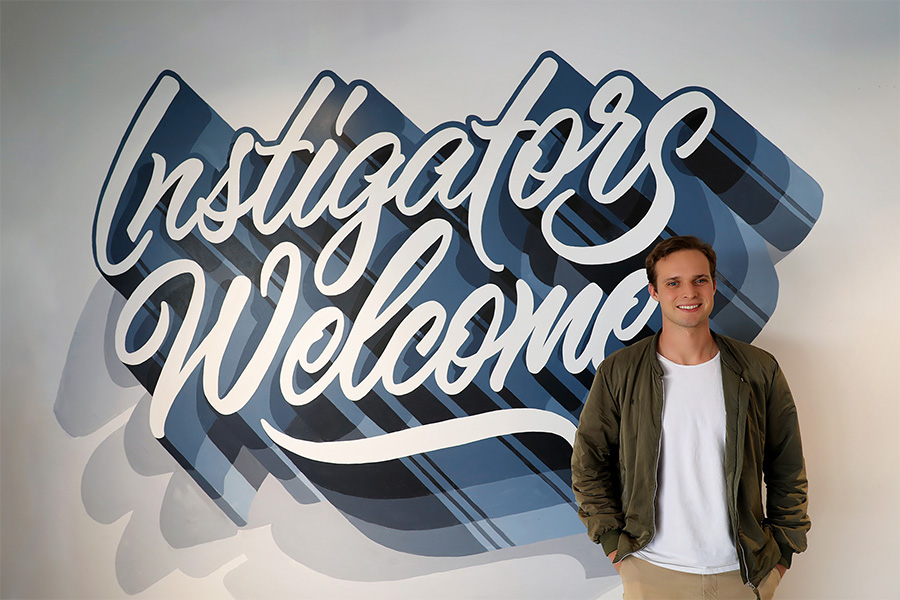
At 25, I shouldn’t be an intern anymore. At least that’s how I feel when I tell people. After graduating college, I felt social pressure to complete a list of unspoken imperatives: apply your degree; have a career; get your shit together; grow up. I studied English literature, so I interned with firms in the fields of comms, PR, and consulting. Each summer I wrote copy and press releases, and each fall I came back feeling dissatisfied. I wasn’t sure what to do, so instead of taking a job at a comms firm in California, I moved to Spain where I taught English and did digital marketing.
At my digital marketing job my boss tasked me with designing a catalog for a tradeshow. She assumed I knew Photoshop (I didn’t) and I assumed it wouldn’t be difficult to learn (it was), so I accepted the assignment. What followed were three stressful days of learning the program’s basic tools, then two days and nights of frantic designing to meet the deadline. To my surprise, the clients liked it. They assigned me another project, then another. Soon I discovered I preferred designing to writing business reports and marketing copy. There have been days when if I had to choose between agonizing through a first draft or pulling my own tonsils out with pliers, I would choose the pliers. But I sank into Photoshop and Illustrator more easily than I did into my writing, and didn’t come up for hours. When I was about to return to the U.S., I assembled my work into a rough portfolio and committed to a second professional education in design work. A few weeks later I was applying for a design internship at Schiefer Chopshop.
When I first showed up, I constantly questioned whether I was up for the task. I’m a self-taught designer with gaping holes in my knowledge of basic design principles and technical skills. Coworkers have accommodated these challenges by having me start long-term projects early. Completing work months in advance allowed me to learn new design skills stress-free. Everyone knows I have a lot to learn and expect me to ask questions frequently. Staff members always oblige, including those beyond the design team. The motion graphics team has taken time to explain how to prep assets they can animate more efficiently, and data analysts have explained which KPIs they use so I can make more effective content.
Creating content that other teams can easily integrate is what separates amateur designers from the professionals. I learned this the hard way in a project I did for Boost Mobile’s Instagram account. For National Superhero Day we drew inspiration from four comic book panels illustrating onomatopoeias— whoosh!, crash!, bang!, pow!—whose sounds we would replace with mobile actions we wanted users to take: tap!, share!, swipe!, like! I had to make sure all my Illustrator paths were organized into layers that could be easily manipulated later. The project seemed simple: the brand guide limited my palette to four colors and gave me one signature font. I finished a first draft that afternoon and revisions immediately followed. Since I had drenched all four panels in halftones and exaggerated my drop shadows, my first marching order was to make the design less busy.
On my next go I rearranged the colors—using only four proved constricting, and it was difficult to find something unique for each panel. Each time I went back, there were more critiques, more details I had missed, and with each round of changes, I encountered new problems. After eight revisions and four hours of reorganizing my layers, the designer gave my work a firm nod and sent it off to the animators. Including time I spent on other projects, this simple post took me two and a half days to complete. It Illustrated the difference between myself and our professional designers: professional designers get more details right and keep their organization pristine in the early stages. Getting these things right shows in their turnaround times and the flawlessness of their designs. The good news is that I’ve continued to receive more client projects and more independence working. I still need to revise my work frequently, but every week I reduce the number of revisions before approval, and I attend to more details earlier in the process.
My internship at SCS has been a compass rose and ship, providing both direction and a means of traversing the seas of post-college life. They’re still stormy most days, but I’m on my way. I’m grateful to SCS for taking a chance on me and helping me start this second education. Where I’m going next, I’m not sure, but my time here has set me on a path toward my passion rather than just meeting everyone else’s expectations.